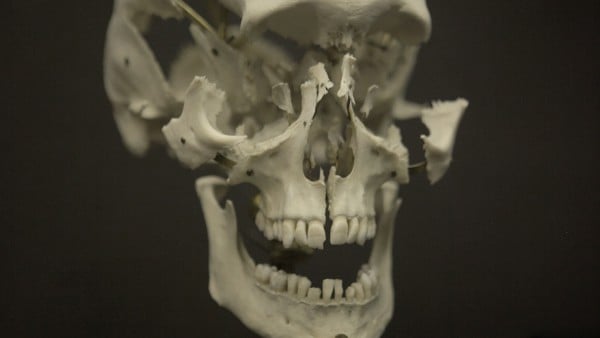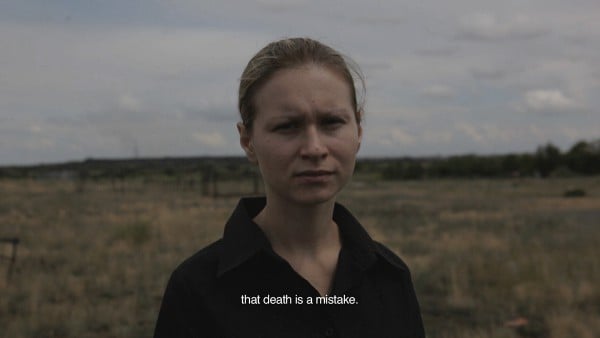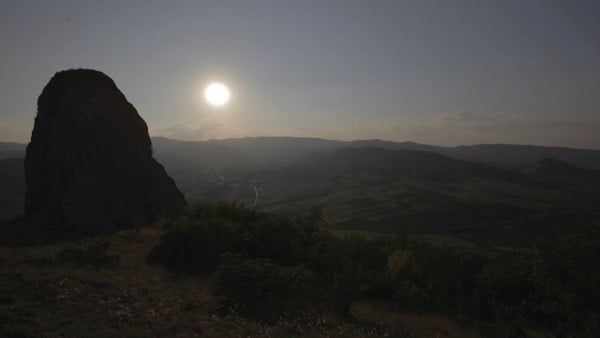Art & Exhibitions
artnet Asks: Anton Vidokle on Immortality through Technology at Garage Museum
Unearthing the Russian philosophy that paved the way for space travel.

Courtesy: the artist and Garage Museum
Unearthing the Russian philosophy that paved the way for space travel.

Hili Perlson


Anton Vidokle, still from This Is Cosmos! (2014)
Courtesy: the artist and Garage Museum
Russian-American artist Anton Vidokle, co-founder of e-flux journal together with Julieta Aranda and Brian Kuan Wood, is working on a trilogy of films that explore the ideas of the early 20th century Russian movement of Cosmism.
Part philosophy, part religion, and part radical futurism, the Cosmo-Immortalists took from theology and ethics—Eastern and Western—to create an idiosyncratic mélange of concrete metaphysics, centered on the belief in technology’s ability to one day resurrect the dead.
The first film in the ongoing project, This Is Cosmos! (2014), is featured in the inaugural exhibition of the Garage Museum for Contemporary Art, which opened in Moscow on June 12. Speaking to artnet News, Vidokle discussed the traces of the utopian project in post-Soviet Russia, the links between environmentalism and space travel, and how Silicon Valley’s quest for body hacking today is indebted to—you guessed it—Russian Cosmism.
How did you start exploring Cosmism?
I only found out about this by chance. Someone asked me to do an interview with Ilya Kabakov for a catalogue, and so I went to visit him. He told me a lot of things I’d never heard of. After I spoke to him, I started looking into it and I realized the incredible depth of information.
Cosmism was basically suppressed by Stalin starting in the 1950s, so it was impossible to openly publish any of the texts or make any references to this set of ideas. In the early 90s things started being published again, although I do think that a lot of artists, filmmakers, and scientists were always aware of it; for example, I see a lot of references to Cosmism in Andrei Tarkovsky’s films.

Anton Vidokle, still from This Is Cosmos! (2014)
Courtesy: the artist and Garage Museum
One of the fundamental ideas of Cosmism was to bring technology to the point where the dead could be resurrected. Can you explain where this idea originated from?
One idea was that evolutionarily we are incomplete; because we’re mortal, our design is not perfect. And we can’t really wait for god to resurrect us. Basically, we have to take this responsibility upon ourselves as a species to use science and technology and all of the productive forces of society to achieve immortality.
But then, there was a second element to it, which is kind of an ethical argument, that we owe a certain debt to everybody that came before us, so we can’t just leave our ancestors to be dead while we become immortal. There’s an obligation to go back and resurrect everybody who’s ever lived—starting with Adam, because most of this is derived from Christian ideas.
Nikolai Fyodorov was the person that started this in Russia, in the 1860s. You know, in the 18th century God was already kind of dead. So there was a very big philosophical and spiritual crisis, where some form of immortality needed to be reinvented that isn’t a religious immortality of the soul.
I try not to be ironic about it, because these people were so brilliant I cannot discount them. They were such powerful, imaginative thinkers, that I can’t simply say, “oh this is a silly idea.” It’s actually rather substantial. Maybe it’s not what we consider to be pragmatic or rational right now, but there is an incredible strength to this weird poetry, to this intense desire for transformation, for evolution.

Anton Vidokle, still from This Is Cosmos! (2014)
Courtesy: the artist and Garage Museum
So Cosmism was more religious than say, futurist?
It was futurist too, but that was a later phase. The founder of this movement died before the revolution, but by that time, he had already influenced a whole generation of thinkers, artists, composers, scientists, and writers. He mobilized the intellectual elite of this country. So this project continues and by the time the revolution happens, because Marxism and Communism are kind of materialist ideologies, they naturally fused with a lot of ideas of Cosmists. And a lot of early people within the Bolshevik party were followers of Fyodorov. In the beginning, there was quite a close connection between the two ideological groups; there was even a party of Cosmo-immortalists, who had three or four seats within the first Soviet Congress. They tried to pass a legislation—and they succeeded—about freedom of interstellar travel and the right to immortality.
How long were these laws in effect?
They existed for 2-3 years, then most of them were either jailed, or … A lot of it ends tragically, a lot of them were executed, a lot of people went to labor camps.
It was perceived as a heresy in relationship to the orthodox interpretation of Russian Marxism. After the revolution, there were a lot of different sects of the Communist Party: some of it was closer to anarchism, some of it had very spiritual undertones. By 1930, Stalin wanted to solidify—it’s almost like what Christianity went through in the 4th century: there were so many different interpretations of Christianity, but then there was the consensus version of what is in the Bible, which is the proper way to worship God … etc. Something similar happened with the Communist Party here in the late 1920s-early 1930s, and all of the stuff that was perceived to be not sufficiently correct was banned.

Anton Vidokle, sill from This Is Cosmos! (2014)
Courtesy: the artist and Garage Museum
How difficult was it for you to come upon material in your research?
Some of it is very easy. Fortunately a lot of writings of Fyodorov are published now. The difficulty is that there is a huge amount of information, it’s really vast, because basically, the more I look into this, the more I realize that it was so influential in a certain way that almost every artist from the avant-garde movement—as well as scientists and many political leaders—were all infected with this idea. It’s really hard to say where it stops. To really get a grasp on it, you have to not only read philosophical works, but also poetry, and plays, look at cinema, read scientific books.
Because it was about this technological immortality, science, of course, plays a key role, and a lot of the scientists were very prolific writers, like Konstantin Tsiolkovsky for example, who invented the idea of space flight and all of the mathematical formulas for a rocket design. He wrote something like 400 books, half of them are actually science fiction. So it’s so much material that I could spend the next 20 years just reading.

Anton Vidokle, still from This Is Cosmos! (2014)
Courtesy: the artist and Garage Museum
From today’s point of view, Cosmism isn’t very environmentally sound. How was the planet to sustain the whole of resurrected humanity?
That’s precisely the reason for the Russian space program. Fyodorov realized that there are too many of us to inhabit this planet, which is why he insisted that we must design spaceships, we must learn to live in space, to colonize other planets, to build space stations. This is one aspect of Cosmism that was materialized. Most people don’t connect the two together, but it’s completely because Tsiolkovsky, the man who invented rocketry, was a student of Fyodorov.
How has Cosmism influenced Russian art?
Art was such an integral part of this movement, and it’s quite interesting how most of these people perceived art, as a technology of resurrection and immortalization, on par with science, on par with medicine.
Art is something that has the potential to bring life back or to resurrect, and they thought that it needed to be radicalized in order to achieve that. And in a sense, it became a project of the avant-garde: production of a new human being, this whole construction of a future architecture, of life and space, of Suprematist works.
In America, for example, there’s a very formalist understanding of the Russian avant-garde, but actually, very little of it is formal. It’s not so much about picture planes, form, and color. A lot of them are quite literal illustrations of certain ideas: of what it would be like to live in the conditions of weightlessness, what it would be like to reconstruct your body in such a way that you would be able to exist in space, without oxygen, without food, what it would be like to just derive energy from the sun, or something like that. So it becomes much more interesting that an analysis of the formal elements of painting.

Anton Vidokle, sill from This Is Cosmos (2014)
Courtesy: the artist and Garage Museum
What do you think Cosmists would make of today’s tech companies’ body hacking endeavours?
Of course, there is a continuation of research. There is a kind of overlap between Transhumanism, Posthumanism, and Cosmism. Actually one of the key people in the field is Ray Kurzweil, chief science engineer at Google. He is trying to resurrect his father, who was a concert cellist or pianist at the Metropolitan Opera, and died quite young of a heart attack. So he collected all of the things that belonged to his father—his records, his clothing, his body tissue samples, his urine.
Ray himself is a very brilliant computer scientist, so he’s trying to build software to somehow interpolate different characteristics of his father to reconstruct his consciousness as artificial intelligence. But this is also the person that invented the flatbed scanner, and a lot of things we actually use every day. So there is that. In America, it’s kind of a big field, this Posthuman/Transhuman research. This merger between artificial intelligence and human body.
Something happened in Russia in the 19th century; there was a gigantic leap, which then resulted in the communist revolution—which was, in turn, also a gigantic leap. I’m still trying to figure out what happened.
Anton Vidokle, “This is Cosmos” is on view at Garage Museum for Contemporary Art from June 12–August 23, 2015.